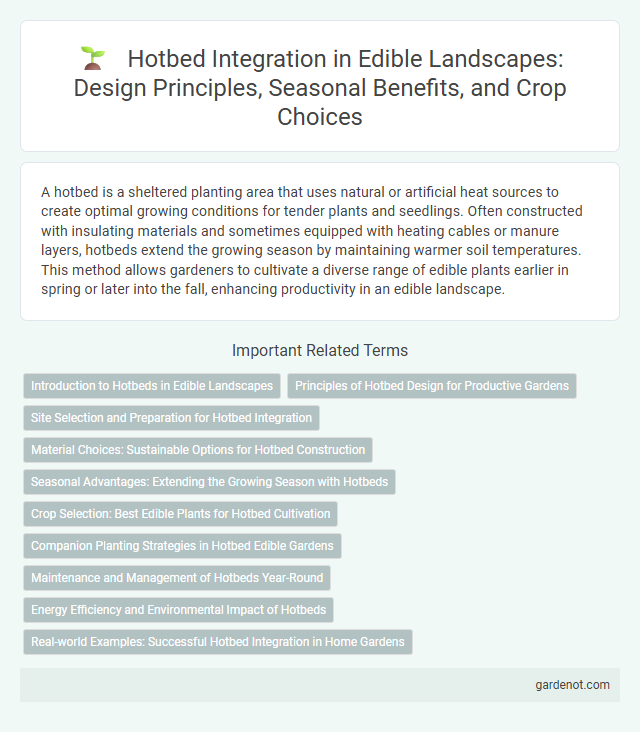A hotbed is a sheltered planting area that uses natural or artificial heat sources to create optimal growing conditions for tender plants and seedlings. Often constructed with insulating materials and sometimes equipped with heating cables or manure layers, hotbeds extend the growing season by maintaining warmer soil temperatures. This method allows gardeners to cultivate a diverse range of edible plants earlier in spring or later into the fall, enhancing productivity in an edible landscape.
Introduction to Hotbeds in Edible Landscapes
Hotbeds are an essential component in edible landscapes, providing a warm microclimate that extends the growing season for vegetables and herbs. Typically constructed with layers of decomposing organic material, such as manure and leaves, hotbeds generate heat through natural decomposition, promoting faster seed germination and early plant growth. This sustainable method enhances soil fertility and supports healthy, vigorous plants in temperate climates.
Principles of Hotbed Design for Productive Gardens
Hotbed design for productive edible landscapes relies on maximizing soil warmth and nutrient availability through controlled insulation and organic matter layering. Incorporating materials like manure beneath a soil layer promotes microbial activity and heat generation, accelerating plant growth cycles. Proper ventilation and moisture control are essential to maintain optimal conditions, ensuring robust seedling development and extended growing seasons.
Site Selection and Preparation for Hotbed Integration
Selecting a site for hotbed integration requires well-drained soil with full sun exposure to maximize heat retention and plant growth. Preparing the area involves digging a trench to accommodate organic matter such as manure and straw, which generates heat through decomposition, ensuring the bed remains warm. Incorporating a clear plastic cover can enhance soil temperature, promoting efficient seed germination and extending the growing season within an edible landscape.
Material Choices: Sustainable Options for Hotbed Construction
Sustainable hotbed construction relies on eco-friendly materials such as reclaimed wood, straw bales, and recycled glass to maximize insulation and longevity. Using natural, biodegradable materials like hay or compost also enriches soil fertility while minimizing environmental impact. Incorporating transparent, UV-resistant plastics or glass for covers ensures optimal sunlight transmission and heat retention, enhancing plant growth in edible landscapes.
Seasonal Advantages: Extending the Growing Season with Hotbeds
Hotbeds leverage soil warmth and decomposing organic matter to create microclimates that extend the growing season for vegetables and herbs. By maintaining higher soil temperatures during early spring and late fall, hotbeds enable earlier planting and later harvesting, maximizing crop yields. This technique reduces frost risk and supports continuous production in temperate climates, making it essential for sustainable edible landscapes.
Crop Selection: Best Edible Plants for Hotbed Cultivation
Tomatoes, peppers, and eggplants excel in hotbed cultivation due to their high heat requirements and rapid growth in controlled warm environments. Leafy greens like spinach and Swiss chard also thrive, benefiting from the consistent warmth and moisture regulation hotbeds provide. Root crops such as carrots and radishes perform well in hotbeds, gaining an extended growing season and enhanced soil conditions for optimal edible yield.
Companion Planting Strategies in Hotbed Edible Gardens
Companion planting in hotbed edible gardens enhances growth by pairing compatible plants like tomatoes with basil, which improves flavor and deters pests. Utilizing nitrogen-fixing plants such as legumes alongside nutrient-demanding vegetables optimizes soil fertility within the confined hotbed environment. Strategic plant combinations maximize space, promote healthy microclimates, and increase overall productivity in hotbed edible landscapes.
Maintenance and Management of Hotbeds Year-Round
Maintaining hotbeds year-round requires consistent monitoring of temperature and moisture levels to ensure optimal soil conditions for plant growth. Regular removal of old plant material and replenishing organic matter supports soil fertility and pest control, while ensuring proper ventilation prevents overheating and fungal diseases. Seasonal adjustments, such as adding insulation during winter and managing shade in summer, optimize the microclimate for extended growing seasons.
Energy Efficiency and Environmental Impact of Hotbeds
Hotbeds maximize energy efficiency by harnessing decomposing organic matter to provide natural heat, reducing the need for external energy sources. Their design minimizes environmental impact through sustainable use of biodegradable materials and lowered carbon emissions compared to conventional heating methods. This eco-friendly approach supports year-round cultivation while conserving resources and promoting soil health.
Real-world Examples: Successful Hotbed Integration in Home Gardens
Home gardeners in temperate climates have successfully integrated hotbeds by using cold frames filled with composting manure to extend the growing season for tomatoes and peppers. Urban gardening projects in Seattle utilize solar-heated hotbeds to start seedlings earlier, resulting in more robust plants and higher yields. In rural England, traditional hotbeds covered with glass or plastic provide microclimates that enable the cultivation of heat-loving crops like melons and cucumbers in otherwise cool conditions.
Hotbed Infographic

 gardenot.com
gardenot.com